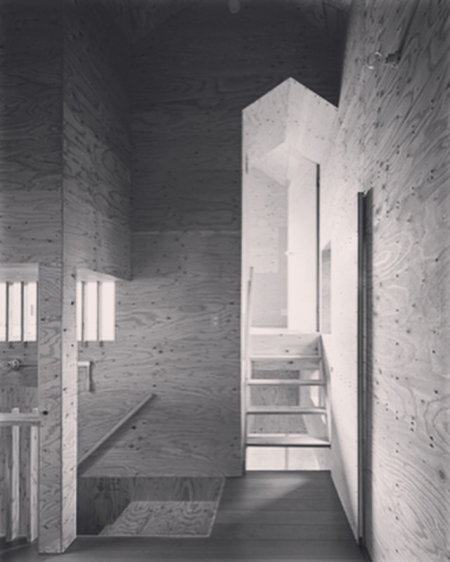空間の形
日常の物語を形づくるのが、建築の設計であり、空間は日常の生活のアウトラインを描き出すと考えている。
空間にはそれだけの影響力があるだろう。
建築は内部に空隙とも呼べる空間があり、そこに人が入り込むことができるから建築となる。入り込んだ時に見える範囲で日常の生活が行われるから、建築の空間の範囲が、日常の生活の行動の範囲、すなわち、アウトラインとなる。
そのようなことは当たり前だが、アウトラインということは、それを形として認識することもできる。
日常の生活とは人の営みであるから、人の営みを形として認識することができ、それは、人の営みを形として表現できることでもある。
すなわち、空間を形として認識することができ、空間を形として表現できることでもある。
今まで空間を形として認識したことは無いかもしれない。形として認識するものは中身が詰まったものか、全体を俯瞰的に見ることができるもの、だから、建築を外から見た場合は、形として、それを審美的に見ることになるが、入り込んだ空隙の中で、その空隙を、その空間を、形として、審美的に見ることは無かったし、そもそも、そのような視点は無かった。
だから、空間を形として意識してみると、そして、その形が人の営みだと考えてみると、床、壁、天井の面としての境界のあり方や存在の仕方が、今までとは違う意味合いで見え、随分と、不自由な形の中に人は押し込められて日常の生活を送っているのではないか、などと考えてしまう。
ただ、それは当たり前のことで、空間の形は、人の営みがまず先にあって、それを元に決めているように見えて、ほとんどの場合は、人の営みとは関係が無い、法規や予算や建築の構造などの制限を元に決めているのである。
そうなると、今まで空間の形を決めてきた要因以外のもので、空間の形を決めていけば、この不自由な形から抜け出すことができる、それも、「人の営み」そのもので、直に空間の形を決めていけばよい。
ただ、「人の営み」ではあまりにも抽象的であり、それをそのまま空間の形の決定要因にすると、それは言葉上のレトリックを使い、これが「人の営み」から直に生まれた空間ですなどと、どうにでも言葉で補完できてしまうものにしかならないから、「人の営み」をもっと建築的に、ただ、従来のお決まりの建築的表現ではないもので、具体的にもっと限定した表現にしていく必要があり、それがつくり手独自の表現にもなる。
なので、ずっと人の「気分」に焦点を当てて、空間の形を考察している。
"Shape of space"
It is architectural design that forms everyday stories, and space is considered to outline daily life.
Space will have that much influence.
Architecture has a space that can be called a void inside, and people can enter it. Since everyday life is performed in the range that can be seen when entering, the range of the space of the architecture becomes the range of behavior of daily life, that is, the outline.
That's natural, but an outline can be recognized as a shape.
Since everyday life is human activity, we can recognize human activity as a form, and it can also express human activity as a form.
In other words, space can be recognized as a shape, and space can be expressed as a shape.
You may not have ever recognized space as a shape. What is recognized as a shape is something that is packed or can be seen from a bird's-eye view, so if you look at the architecture from the outside, you will see it aesthetically as a shape, but get in However, in the gap, the gap, the space, and the shape were not seen aesthetically, and there was no such viewpoint in the first place.
So, when you think about space as a form, and think that form is a human activity, the way of boundary and presence of floors, walls, and ceilings is different from the past It looks like a meaning, and I think that people are forced into a crippled shape and lead their daily lives.
However, it is natural, and the shape of the space seems to be determined based on human activities first, and in most cases it is not related to human activities. It is determined based on restrictions such as budget and construction structure.
Then, if you decide on the shape of the space with factors other than the factors that have determined the shape of the space so far, you can get out of this inconvenient shape. You just have to decide the shape of the space.
However, it is too abstract in "people's activities", and if it is used as a determinant of the shape of the space as it is, it uses a verbal rhetoric and this is a space that was born directly from "people's activities". Because it can only be supplemented with words, the "people's work" is more architecturally, but it is not a traditional architectural expression, but a more specific expression. It is necessary to go and it becomes the original expression of the creator.
So, I have been focusing on the "feeling" of people and studying the shape of space.

